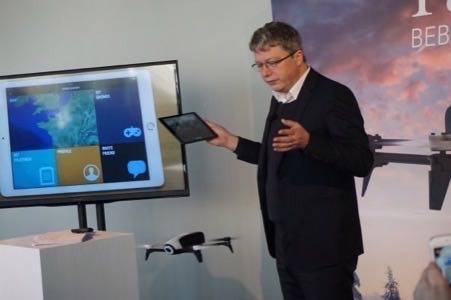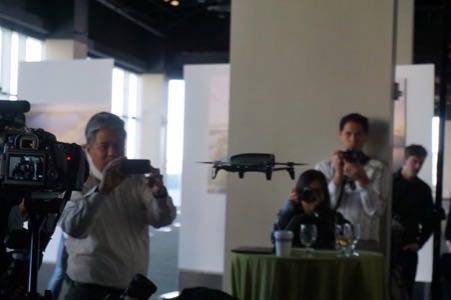Drone maker Parrot’s new flying gizmo, the Bebop 2 Quadricopter drone, will make its landing next month, just in time for holiday shoppers. According to the company, it’s a smaller, lighter, and easier-to-use model than the previous Bebop drone—which should please consumers interested in tossing one in a bag.
For developers, the improvements could help them make a better case for whatever uses they envision—but the company hasn’t yet delivered everything they need to build new drone-based applications.
The “flying camera,” as Henri Seydoux, Parrot’s founder and CEO, puts it, may be a consumer product, but he’s keenly interested in what companies and developers will do with it. The unit, which will sell for $550 when it launches on December 14 ($800, with the updated Parrot Skycontroller Black Edition included), features better stabilization without the bulk of extra hardware and improved range for remote control.
See also: New Mandatory Drone Registration: The Worst-Case Scenarios
During the presentation, Seydoux showed off a few examples of what third parties have done with the technology. But there’s no word on when a new software development kit (SDK) might arrive to let them take advantage of the new features.
He later explained to me that the company is working on the SDK, which will arrive at some point later on. Then he explained where he thinks the most interesting opportunities are for drones, and the big hole that no one seems to have filled yet.
Lifting Off

During the presentation, Seydoux highlighted a couple of drone software developers. Pix4D created mapping software that can take footage from the drone to recreate 3D maps of neighborhoods and other areas. Neurala developed a way to take drone selfies.
What fascinates Seydoux most, however, are the deep scenarios that go beyond recreation and employ drones to do what humans can’t.
“We have companies that we work with that use the drones for archaeology,” he told me, explaining how scientists managed to create very accurate 3D maps of Pompeii from drone footage. “Those kinds of apps are very, very interesting to us.”
When it comes to uses, there’s still one obvious missing piece for Seydoux: “[What] I expected, and have not seen up to now, is some nice gaming apps with the drones,” he said. “It’s still not there.”
Gaming Drones

Gaming seems like a natural target for the technology. Together with a virtual reality headset connected to the Skycontroller, a user could get the bird’s-eye view of what the drone sees. But game developers mostly place their expensive bets on well-established platforms with fleshed-out software-development tools. (Facebook’s Oculus VR gets this, which is why it’s been courting game makers with a series of developer conferences.)
Even without a controller, the updated mobile app lets iOS and Android users control the action by physically moving the smartphone or tablet. Software could let drone pilots reach virtual goals on screen by flying their real-life drones up to certain altitudes or performing airborne tricks.
An updated software development kit will likely take advantage of the new model’s more compact size, 3-axis digital stabilization (for steadier image or motion capture), and durability. The Bebop 2 has virtually no moving parts, Seydoux said, aside from the propellers, thanks to the improvements coming largely from software.
Other features: The Bebop 2 can fly up to 25 minutes, thanks to its 2700-mAh battery, and features a 14-megapixel camera (the same as the first Bebop) which is capable of 1080p full HD video capture, a fisheye/180-degree lens, flexible 6-inch propellers that stop on contact, 8GB storage, flash LED for better visibility, built-in GPS, and a weight of just over 1 pound.
The device can reach a maximum speed of 60 kilometers, or a little more than 37 miles, per hour. Parrot also equipped the Bebop 2 with longer propellers, for a better “thrust-to-weight” ratio. It can reach 100 meters, or 330 feet, in altitude in 18 seconds.
The company tested the device in a wind tunnel, in literal mountain conditions out at Mont Blanc, and even the North Pole. It wants to make sure this drone is ready for whatever comes next—whether that’s out in the world or within the market. Now, it just needs to let the world’s drone-app dreamers put it to the test.
Photos by Adriana Lee for ReadWrite










